Oxygen Market
Getting the Lay of the Land
Our third annual respiratory therapy survey continues to show a shifting marketplace.
- By Joseph Duffy
- Apr 01, 2012
 Competitive bidding continues to change the outlook of respiratory therapists. According to last year’s survey, 33.1 percent of respondents pointed at competitive bidding as the single-biggest challenge facing the homecare industry. The 36-month cap on oxygen reimbursement came in at No. 3 (33.1 percent). This year, competitive bidding reclaims its throne, with 43.9 percent of respondents calling it the homecare industry’s biggest challenge. The 36-month cap falls to fourth place, with 12.7 percent of respondents.
Competitive bidding continues to change the outlook of respiratory therapists. According to last year’s survey, 33.1 percent of respondents pointed at competitive bidding as the single-biggest challenge facing the homecare industry. The 36-month cap on oxygen reimbursement came in at No. 3 (33.1 percent). This year, competitive bidding reclaims its throne, with 43.9 percent of respondents calling it the homecare industry’s biggest challenge. The 36-month cap falls to fourth place, with 12.7 percent of respondents.
“I am very concerned that further cutbacks and competitive bidding will affect my job and job security, and am deeply concerned about quality of care being deeply compromised, as well as the quality of equipment,” says one survey taker. “We are also concerned about all the Medicare audits — it is very time consuming to dig up information that was already sent and sometimes approved and paid. I think it is extremely unfair to go back three to four years and ask for documents. We have run into quite a few patients who are deceased and it’s very difficult to get the documents that are requested.”
Respondents were especially critical this year, offering many opinions of their changing industry. Today’s homecare industry professionals see a highly demanding field where patients are being affected by cuts, caps and competitive bidding. Providers enjoy their jobs and patients remain the most important point of focus as it becomes harder to do more for them.
“I believe homecare therapists have the chance to help further educate patients in their home environments but this is not an option for all therapists these days because of cuts,” says a respondent. “We cannot take the time to further educate our patients in the home. We can also see things that may be beneficial in the home or patients conditions but are not given the chance to follow up or recommend with physicians and expand patient therapy to a broader form to decrease patients from returning to hospitals and physicians. Re-education of patients and follow-up in the home with patients are keys to helping patients make good, informed choices and helping them get better care for their conditions.”
ABOUT THE SURVEY RESPONDERS
This year’s survey was comprised of respondents from all major regions of the United States. The Midwest had the most respondents, with 34.8 percent of all survey-takers. The East had 33.3 percent, the South had 21.7 percent, and the West had the least with 10.1 percent. Other respondent statistics include:
- 58.6 percent have RRT certification, while 42.8 percent have CRT.
- 75.2 percent have 15 years or more experience, where 4.4 percent have less than two years’ experience.
- 32.9 percent devote 26 percent to 50 percent of their time to oxygen therapy, while 2.1 percent devote more than 90 percent of their time.
- 30.5 percent devote 50 percent to 75 percent of their time to sleep therapy.
- 48.8 percent devote less than 10 percent of their time to asthma therapy.
- 51.6 percent devote no time to ventilation therapy, where 0.8 percent devotes more than 90 percent of their time.
BIGGEST CHALLENGES
For the second year in a row, competitive bidding is the singlebiggest challenge facing the homecare industry, according to 43.9 percent of respondents. There were no positive respondent comments about competitive bidding. They were all reflective of this survey-takers concern:
“Competitive bidding is the worst thing that has happened to our industry. Service and respiratory care are going out the window. The cheapest equipment and cheapest care will be the norm, all to the detriment of the patient. Hospitalizations will skyrocket and the cost of healthcare will increase tremendously.”
Interestingly, this year, 17.2 percent of respondents said a lack of reimbursement for home respiratory therapy services was the single-biggest challenge facing the homecare industry, where last year, 28.2 percent of respondents (very close to last year’s competitive bidding’s 33.1 percent) said it was the single-biggest challenge.
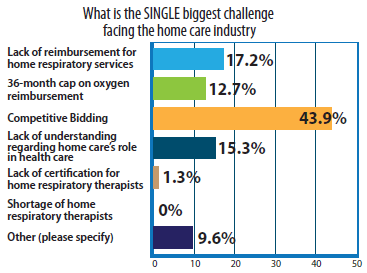
COMPETITIVE BIDDING
Round Two of the competitive bidding program officially started taking bids in February of this year in 91 competitive bidding areas.
The program will see bidders from across the nation placing bids on any category in nearly any MSA they choose. Round Two could see a massive, nationwide reordering of the home medical equipment sector and the patients it serves.
Of the respondents for this year’s survey, 50.5 percent are located in a competitive bidding area for Round Two and 9.6 percent are in a competitive bidding area for Round 1. Almost 40 percent of respondents said they are not located in a competitive bidding area. According to the survey, 57.1 percent of respondents are bidding for oxygen services in Round Two of competitive bidding, where 58.8 percent are bidding on sleep services.
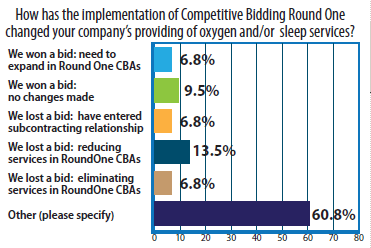
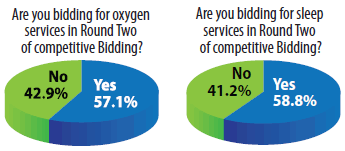
LOOSENING THE CAP
Although on a downward spiral of concern since 2010’s survey, the 36-month rental cap is still affecting the way providers do business. When asked how the 36-month reimbursement cap has changed your company’s approach to clinical services for these patients, 48.4 percent of respondents said they reduced the frequency of in-person therapist follow-up visits. Even though the cap has been downgraded as a concern, this is up from last year’s 45.1 percent.
When asked how the reimbursement cap has changed your company’s approach to equipment and oxygen delivery for these patients, 43.3 percent of respondents said they were transitioning to nondelivery models, up from 32.8 percent from last year. According to last year’s survey, 42 percent of respondents reported that using home transfilling systems was how the cap changed their business. This year, that same answer has fallen to 37.8 percent.
According to the majority of respondents (15.7 percent), 21 percent to 25 percent of their oxygen patients have reached the 36-month reimbursement cap.
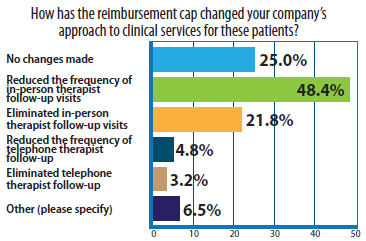
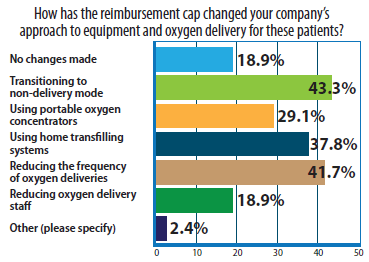
PATIENT COMPLIANCE
The more cuts and caps that ripple through the industry, the more difficult it may be to achieve patient compliance. A comparison of last year’s and this year’s results, however, show similarities in concerns and how respondents are trying to improve patient compliance.
One survey-taker seems to sum it up: “It’s getting more and more difficult to service patients because time resources are spent on paperwork and reimbursements are getting lower and lower.”
For sleep therapy, difficulty with masks or interfaces is the No. 1 barrier to patient compliance, according to 55 percent of respondents. For oxygen therapy, bulky/burdensome equipment is the No. 1 barrier, per 39.9 percent of respondents.
Like last year, making follow-up calls to patients is the No. 1 method used to address or improve patient compliance (85.1 percent of respondents). Making follow-up visits to patients’ homes to address or improve patient compliance fell from 63.1 percent of respondents last year to 56.7 percent this year.
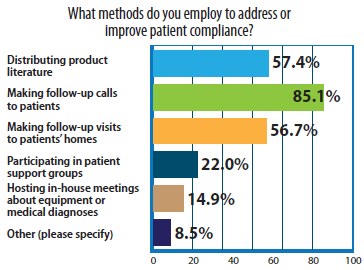
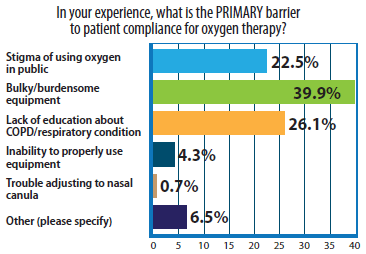
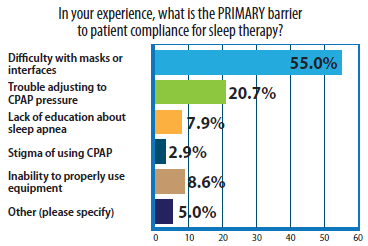
“There is a declining role for therapists in the homecare field,” says a survey-taker. “We used to focus on disease management programs and clinical education. Homecare is turning into a delivery service only. It’s a shame we are not seen as a valuable resource. Homecare should provide a preventative method to hospital admissions and increasing medical costs, while improving the patients quality of life and activities of daily living.”
This article originally appeared in the Respiratory & Sleep Management April 2012 issue of HME Business.